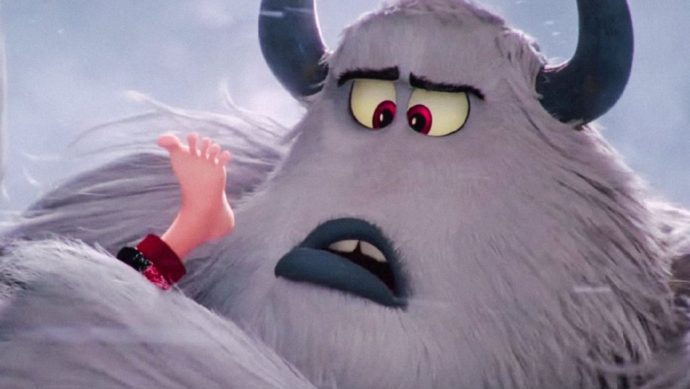Looking at the filmography of the relatively new Warner Animation Group, best known for the Lego movie series and Storks, there’s a clear sense that the creatives in charge of the company have a clear love for Warner Bros. favorites like the Looney Tunes, as each of their films feature slapstick, witty dialogue, and goofy tones. Smallfoot is no exception, depicting a reversal of monster movies where a yeti discovers a mythical being known as a “smallfoot”, which is really just a human being, and attempts to prove to his close-minded village that they exist. But while The Lego Movie was able to have brilliant animation and designs, as well as a fantastic deconstruction of Chosen One narratives and individualism, and Storks had some of the strongest exaggerated goofy animation in years, Smallfoot is a pretty standard and generic affair, failing to deliver on an engaging story or clever comedy, despite some pretty killer visuals.
The film’s basic premise is a literal reverse Bigfoot scenario, but the film’s main message focuses on the idea of questioning long-held beliefs and rules laid down by generations before. The leading yeti Migo, played by Channing Tatum, discovers that the traditions, rules, and beliefs that are literally written in stone and are held by his village and enforced by the leader of the tribe, The Stonekeeper, played by Common, are revealed to be false. He not only learns that smallfoots exist, but also learns the mountain he and his village lives on isn’t held up by giant mammoths, and the sun does not get risen through his father hitting a magic gong.
It’s certainly a bold message to tackle, especially for a family film, but the issue comes with not only how heavy-handed the film is, to the point where it seems like the movie stops just to relay the message, but how it’s forced into a screenplay that attempts to juggle multiple characters and plotlines, never succeeding in doing so. Included with the basic premise and main message are plots that include Migo and his relationship with his father and love interest, the titular smallfoot, a Steve Irwin-esque television host who has lost his passion for his work and is desperately trying to become a viral sensation to save his show, Migo’s father starting to see his faith dwindle, The Stonekeeper’s grasp and power over his village, and a group of Yetis who believe that smallfoots exist, all the while cramming in some one-liners and slapstick, and a handful of musical numbers.
Director Kasey Kirkpatrick’s screenplay, while having a decent laugh here and there, with a pretty funny conflict between Migo and a bear being the comedic highlight, fails to develop or give equal treatment to any of these plots and characters, to the point where certain plot elements, especially a character change with Migo in the third act, feel contrived and half-baked. In turn, the film feels rushed, attempting to cram in so many plot elements in a goofy 96-minute comedy. The characters especially feel empty, as most of them are either forgettable or annoying. It’s a real bad sign for an animated movie where I remember the names of the voice actors more than the names of the characters they played. At least that funny viral video will never let me forget that Zendaya is Meechee.
What does work in Smallfoot however is the animation. It’s clear the team at Sony Pictures Imageworks gave this film their all, as the character and production designs are solid, the character animation is expressive and rubbery, the slapstick is enjoyable and silly, and the musical numbers, while ultimately pointless to the narrative, deliver some of the strongest setpieces and character animation in the film, with Zendaya’s song, while forgettable, easily delivering some of the best bits of animation in the whole production, and Common’s song being legitimately great and fun to listen to.
Yet in the end, there’s really nothing that makes Smallfoot interesting enough to make it truly worth seeing, outside of some great animation, and is certainly a step down from what Warner Animation Group has delivered in the past. A shame too, since the premise is creative, and its message is bold and important. It truly deserves a better treatment than the one delivered, especially considering the talent that was involved here.
